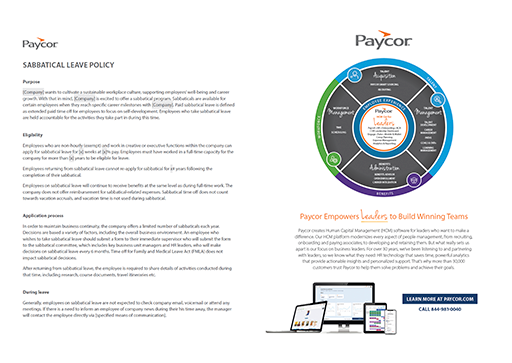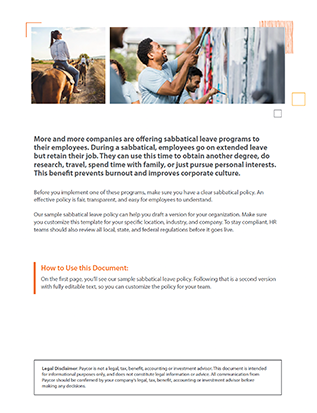Help Employees Avoid Burnout with Sabbatical Leave
Over 80% of employees are at risk of burnout (Fortune). Many workers desperately need a break, and a week at the beach just won’t cut it. What they really need is a few months away from work and the time to pursue personal projects. That’s why a growing number of forward-thinking companies have some sort of sabbatical policy.
What is a Sabbatical Policy?
A sabbatical is an extended break, where employees can step away from work without losing their job. Sabbaticals are very common in academic circles, where professors routinely take a semester or a year off at a time. These leave periods give people a chance to explore other interests, travel, spend time with their families, or do research in their field.
People normally go through an approval process to determine their sabbatical eligibility. Some companies require a minimum time commitment beforehand or require employees to complete certain goals while they’re away. For example, it’s common for people to complete advanced degrees during these leave periods. Employers can also grant sabbaticals at certain milestones, like five or 10 years of employment.
It’s important to note that sabbaticals are different from PTO, FMLA, or maternity leave. These extended leave periods need to be planned much further in advance, because they typically last for months. During the approval process, HR should consider how they’ll fill in the gaps left by an employee’s absence.
The Benefits of a Sabbatical Policy
Sabbaticals can benefit both the employee and the employer. This benefit is a great retention strategy. It builds trust, gives employees something to look forward to, and shows that you care about your team as people – not just as worker bees. It’s also a great way to invest in upskilling your team, since they might pursue advanced degrees during their sabbatical leaves.
By the time an employee puts in a sabbatical request – especially for an unpaid sabbatical – the alternative would almost always be worse. Either they’d leave the company entirely, or they’d stick around with low job satisfaction, low engagement, and low productivity. Sabbaticals give employees the time and space they need to rest and rejuvenate, so they can come back with more focus and commitment than before.
Studies show that sabbatical policies improve employee well-being long after they return from leave (Harvard Business Review).
Potential Downsides of a Sabbatical Policy
Sabbatical leave programs can be hard on HR. They require a lot of administrative work before, during, and after the employee’s leave period. You’ll also have to temporarily backfill their position, which can be a challenge.
An effective sabbatical policy is fair and transparent. Otherwise, you risk lowering morale among other team members. Make sure every employee understands the approval process, so no one feels slighted or left behind.
The biggest risk, of course, is that an employee won’t return after their sabbatical. HR’s best defense here is to build a corporate culture so supportive, they’ll miss it while they’re away.
What to Include in a Sabbatical Policy
Before you write your sabbatical policy, make sure you review local, state, and federal laws for details about employee leave. Make sure your approval process isn’t discriminatory or biased in any way, even by accident. And triple check that you’re offering the right benefits, compensation, and other kinds of support during their time away. Missing any of these details could become a major compliance issue.
As a baseline, most sabbatical policies outline:
- Eligibility: Who is eligible for a sabbatical? Does it depend on an employee’s tenure at the company, job title, reasons for taking leave, or something else?
- Length: What are the minimum and maximum lengths of a sabbatical at your organization? For example, if an employee needs only three weeks off, you might require them to use their PTO or take unpaid time off.
- Pay: During leave, does an employee receive their full salary, partial salary, or no salary? This might depend on what they’re doing during their time away (and whether it’s job-related).
- Benefits: Can employees stay enrolled in health plans and other benefit programs during their leave?
- Access to company email: Are employees on sabbatical expected to check in? If so, how often?
- Application process: What materials should an employee submit to apply for leave? What happens during the approval process, and how long does it take? Who makes sabbatical leave decisions – is it a committee? How many employees can go on leave per year?
- Timing: How far in advance should an employee apply for sabbatical?
- Backfilling roles: What will happen to the employee’s job while they’re on leave?
Sample Sabbatical Leave Policy
Are you thinking about setting up a sabbatical program? Use our sample policy to get started. Once you download the free template, customize it to meet your company’s needs. Make sure you review all local, state, and federal regulations before the program goes live!











